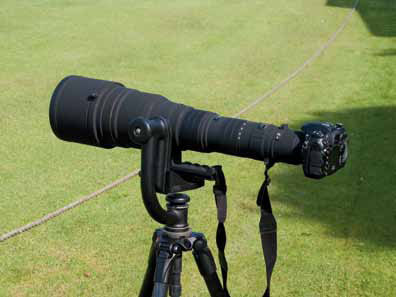articles/Sports/cricketmathstripodsnature-page3
On cricket, maths, tripods and nature - part 3 of 1 2 3 4 5 6 7 8
by Mike McNamee Published 01/12/2009

Cricket photography is all about big lenses to bring the action closer. Here an 800mm lens is mounted on the superlative Wimberley counter balanced head on top of the equally sturdy Manfrotto 535 MPro tripod.
The more detailed shot shows the effect of timing the shutter release to coincide with impact of the ball of the point where the batsman misses the ball and it carries through. The ball is struck about 5 feet from the wicket. At 65 feet/second it will move 6.5 feet between 10 frames-persecond - images, that is about 1half feet beyond the stumps. However, if the batsman plays on to his own wicket or the ball hits the stumps directly, the second frame is in the bag - there will almost certainly be stuff in the air.
Timing is equally important if you are to catch the bowler fully off the ground.
The outcome of this analysis shows why the timing of the photographer has to be almost as good as the batsman's if you are to nail bat-toball contact; but if you do nail that point you are also likely to get the stumps going down, should that occur, using just two or three frames.
Please Note:
There is more than one page for this Article.
You are currently on page 3
- On cricket, maths, tripods and nature page 1
- On cricket, maths, tripods and nature page 2
- On cricket, maths, tripods and nature page 3
- On cricket, maths, tripods and nature page 4
- On cricket, maths, tripods and nature page 5
- On cricket, maths, tripods and nature page 6
- On cricket, maths, tripods and nature page 7
- On cricket, maths, tripods and nature page 8
1st Published 01/12/2009
last update 18/07/2022 16:35:43
More Sports Articles
There are 32 days to get ready for The Society of Photographers Convention and Trade Show at The Novotel London West, Hammersmith ...
which starts on Wednesday 14th January 2026








